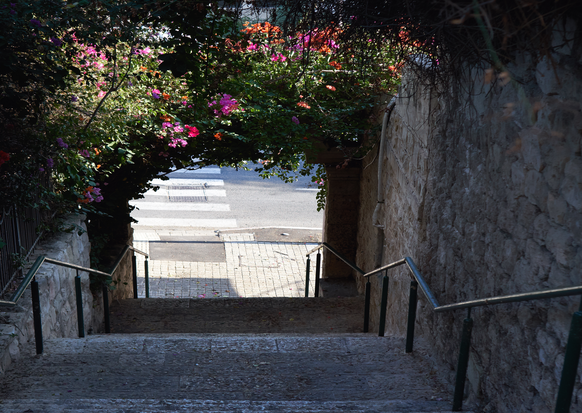Haifa Attractions
Haifa offers a wide range of attractions, many of them within walking distance of the two Dan hotels on the cusp of Mount Carmel. We made a list of some of the leading attractions in the city which has become the perfect destination for a family vacation. The popular tourist sites on the Carmel, the museums and galleries, urban tours in the lower city and the city’s wonderful beaches – if you’re looking for things to do in Haifa with the children, as a couple or on your own, this page is for you.
Local Attractions

THE HEART OF HAIFA: One Thousand Stairs
Let’s go for an urban tour of Haifa’s beating heart, into the Hadar neighborhood. This is an urban tour that’s great for people who love to take a peek at quiet streets and hidden spots across the city which carry the nostalgic memories of the city’s glory days. This urban tour presents authentic Haifa, important and beautiful structures in the city built in the international Bauhaus style of the 1930s. Our walk down the Carmel’s slope lets us encounter this uniquely Haifa aspect of the city. We go through the heart of the Hadar neighborhood and come across countless small and larger stepped paths that link Hadar’s streets. When we come to Massada Street, picturesque and the neighborhood’s center, we can see how, over recent years, it’s become a kind of Soho. We’ll walk along historic Herzl Street and end near the long-time Talpiot Market.
The Steps Tour
Let’s leave the hotel and go south along Hanassi Boulevard. Turning left, we enter Shaar Halevanon Street, which takes us to Yefeh Nof Street, where we turn right and walk some 100 meters up to the sign “Gedera Stairs.” This is where Haifa’s four routes of 1000 stairs begin.
Ancient Haifa was built on the bay’s southern area adjacent to the current location of Rambam Hospital. In 1761, Dahel al-Umar, the governor of the Galilee, destroyed the city and rebuilt it. As the city expanded, new neighborhoods were established further up the mountainside. Over time the stairs connected the lower city to the neighborhoods and the Carmel Mountain, and especially, the main route used by residents.
Let’s go down the Gedera Stairs leading into Henrietta Szold Street, cross the road, and continue to go down as far as Hashmonaim Street. There we take a right and connect to Tuvia Dunya Stairs. Tuvia Dunya was an engineer and founder of the Hadar neighborhood, and among the builders of YMCA Jerusalem.
A short way down, we continue onto the path rather than stairs. The path ends in a T junction where we turn left and rising to a small garden with playground apparatus at the top of Spinoza Stairs. These steps, surrounded by trees, are among Haifa’s prettiest. Where they meet Bar Giora Street, turn right and you'll reach the “Glass House” at 21 Bar Giora Street. This is considered one of the city’s most important and stunning examples of Bauhaus style, planned in 1938 by the architect Theodore Manx as an apartment block. Built around a U shape, its center contains a swimming pool, and a tennis court is located on the roof!
We continue our trek down the stairs found to the left of 15 Bar Giora, known as Haemek Stairs. Let’s go down all the way to where they meet Masada Street, in the Hadar neighborhood’s heart.
Hadar neighborhood is one of Haifa’s oldest, and a central residential quarter in the city. Established as a “garden city” based on Richard Kaufman’s 1922 plans, its commercial hub is located on Herzl and Hehalutz Streets, but other small picturesque side streets literally throb with cafés and shops that attract the younger crowd while maintaining the unique flavor of a village. The same is true of Masada Street, along which are small boutiques, second hand stores, records, vintage and retro shops and bookshops in a surrounding covered by colorful graffiti artwork that fills the street. You might like a short break at one of the cafés before we go further.
From Masada Street, we’ll continue down Kassel Steps and connect to Shmaryahu Levin Street, with its beautiful historic buildings from Hadar’s glory days. Beit Atin on the corner of Kassel and 30 Shmaryahu Levin was built in the 1920s for Yehuda Atin and his family by engineer and architect, and fellow Haifa resident, Gedalyahu Wilbushewitz.
Atin House is a stone structure in an eclectic style. Its two sections are linked by a small corner tower that makes the house seem like a castle. The home served the family only briefly, soon becoming Hadassah Hospital, and later belonging to the Rothschilds. From 2017 on it serves as the “Hiyar” Democratic School, a private organization and the only one of its kind in the Arab sector. Adjacent to the school is the Haifa Elementary School, also occupying a beautiful 1920s structure. But the jewel in the architectural crown, and perhaps one of the most attractive in all Haifa, and definitely on our brief tour, is the Technion structure nearby. Right opposite Atin House you'll find the entrance to the Technion (see the brown sign, “Madatech”). Let’s walk south towards Jerusalem Street to the building’s southern flank. When walking from Shmaryahu Levin Street to Jerusalem Street, we discover the impressive, if not glorious, facade of the building serving as the Madatech Museum. The Technion, being how Bialik coined the name from the outset, opened in 1924. It was planned by the architect Alexander Berwald, who sought to infuse a public and official spirit into the structure by using symmetry and monumentalism relative to the building’s surroundings, much like the Gymnasium School built in the same period in Tel Aviv.
Now we’ll walk south along Jerusalem Street to house number 13 and go down the Hillel Yafeh Steps. Jerusalem Street used to be considered one of the most prestigious, where many of Haifa’s elite used to live, among them Abba Houshi, Haifa’s legendary mayor who lived at number 15. The steps cross Nordau Street and eventually reach Herzl Street, bustling with commercial life at the neighborhood’s center. Herzl Street contains numerous historical buildings, such as number 16, which is the elementary school, opened in 1913 and was also planned by Berwald. Right opposite the steps is the historic Bauhaus style building painted red. It served as the Ora Cinema, built in 1935 and operated continuously until the 1990s.
Now we’ll go to our last stop in our urban tour: the Talpiot Market. Let’s continue walking south on Herzl Street and turn left onto Yehiehli Street, cross Hehalutz Street, and reach Sirkin Street where we make a right… right into the market! This market preserves the unique authenticity of open air markets and has been used by Haifa residents and the neighborhood for more than 80 years! At 35 Sirkin Street we find the roofed Talpiot Market structure which began operations in 1940. The building is of the Bauhaus style, planned by architect Moshe Gerstel. In the early 1990s, the market began showing serious slowdowns, but in 2020 renovations started to restore it to life as part of the municipal strategy of urban renewal for the entire Sirkin neighborhood.
Well, that’s it for now. We recommend heading back to the hotel by using the Carmelit subway. Go back to Herzl Street and walk north as far as Masaryk Square, which is about 10 minutes. There you'll find the Carmelit stations which will take you back to Gan Ha'em which is adjacent to the hotel.


